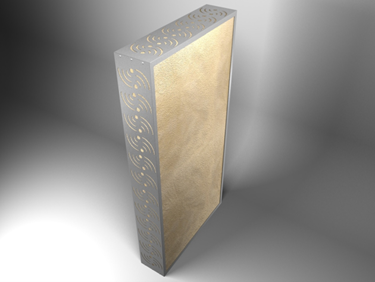When are Acoustical Diffusers Required for Sound Treatment?
Acoustical Diffusers are typically used in band rooms, auditoriums, or any venue where music instruments will be played. They should be used along with acoustic wall panels to help balance the absorption and reflection of high and low frequencies to produce a higher sound quality. Using acoustical diffusers and panels together also prevents a dominant frequency/tone during practices or performances.
Mainly, acoustical diffusers should be used when there is specifically low-frequency noise sources in the space.
- Music: tuba, oboe, drums,
- Performing Spaces
- Practice space: choral, orchestral
Shaping the side walls of a performance venue with gypsum is an alternative. For example, shape the room like a coffin, to prevent parallel walls and reduce low frequencies from accumulating in corners. Some venues will also shape the drywall itself into a large barrel to help change the shape of the room.
Learn More: Re-Wrapping Acoustic Diffusers in a Multi-Purpose Space
Types of Acoustical Diffusers
Diffusers come in a variety of sizes, but they typically come in one of two shapes – Barrel & Pyramidal. Pyramidal diffusers work to diffuse all frequency ranges, while Barrel diffusers mainly diffuse very low and very high frequency sounds. This is typically why the Barrel Diffuser is more popular, most people only need the low frequency diffusion, especially if they’re also already using acoustic absorption panels.
Acoustical Diffusers can have a natural finish, which is just textured white, or they can be fabric finished. Most people opt for a fabric finish to either match the acoustical wall panels in a space, or they choose another accent/complimentary color for the room.
Difference Between Acoustic Diffusers & Acoustic Panels?
Unlike acoustic absorption panels, which are soft and porous (which allows them to absorb sound), diffusers are dense and reflective, and shaped in a curve or pyramid, so that they can reflect an inbound sound wave into dozens of directions. This helps to break up the sound, especially when the wavelength is too low to be effectively absorbed. In these cases, the only option is to “diffuse” the sound into many directions, which causes it to lose strength.


Acoustical Diffusers are typically spread out around a room, similar to fiberglass panels. They can either be wall mounted or placed in the ceiling grid, alternating with the ACT.
Remember these rules of thumb when hanging acoustic panels and diffuser:
- Do not put all diffusers on one wall, spread them out evenly throughout the room
- Do not leave parallel walls untreated, this will cause standing sound waves
- Hang diffusers high enough to be out of reach of people and activities to avoid damage and dirt
Difference Between Acoustic Diffusers & Bass Traps?
Bass Traps & Diffusers are both for Low-Frequency specific solutions. However, Diffusers are made of a hard plastic shell, and diffuse/scatter the sound, while bass traps are made of a fabric-wrapped fiberglass or foam core, and are placed in corners to focus absorption on low-frequencies.
Neither bass traps nor acoustical diffusers are needed for most applications – only recording studios, control rooms, and high-end listening environments where broad-frequency clarity and precise listening conditions are critical to audience.
Bass traps are almost always installed in corners of rooms because low-end sounds tend to congregate in these areas. Depending on which part of the room you are sitting in, this can dramatically affect the clarity of sound. Instead of a warbled, one-note sound, bass traps help achieve a precise clarity — without losing any of that bassy impact.
When Acoustical Diffusers are Needed for Sound Treatment
Acoustical diffusers should be used in band rooms, performance venue, and anywhere there will be low frequency music instruments being played. In these types of rooms, sound diffusers should be paired with acoustic absorption panels. Since absorption panels absorb mid-to-high frequency, and sound diffusers diffuse and dissipate low frequency sounds, the diffusers help to create a more balanced sound quality within music venues.



